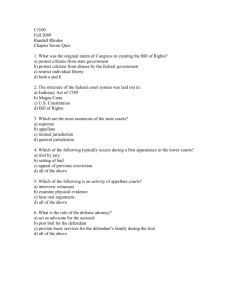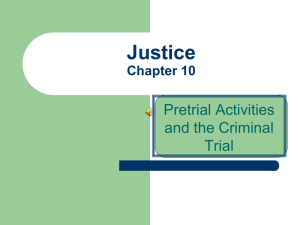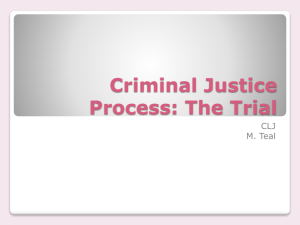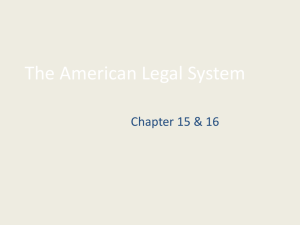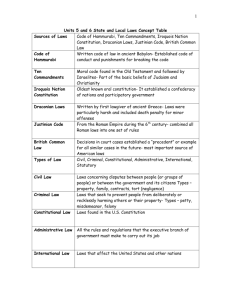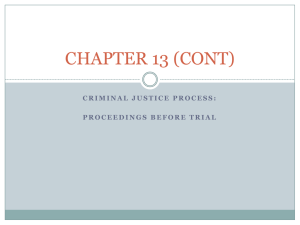unit 3 courts - Pequannock Township High School
advertisement
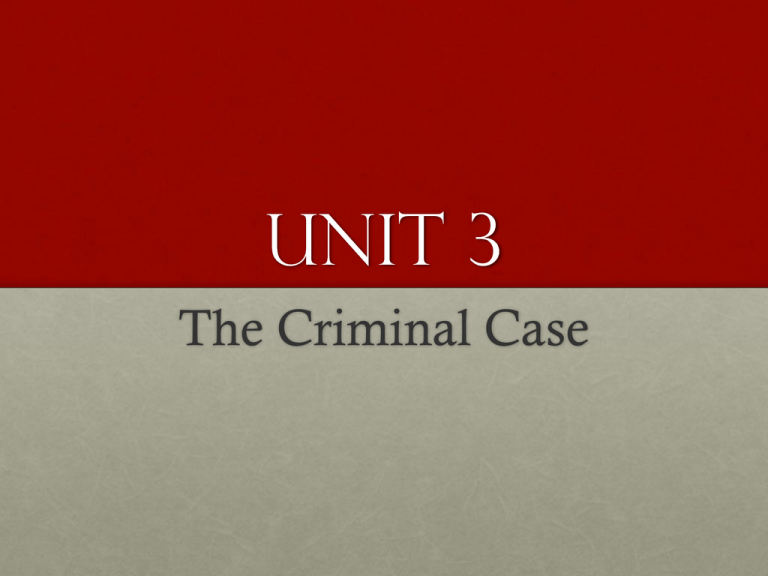
Unit 3 The Criminal Case The federal Courts The federal Courts • System consists of 3 basic levels • District Courts • U.S. Court of Appeals • U.S Supreme Court District courts • Handles trials in the federal system • A single judge presides over a criminal trial Trial by Jury Trial without Jury Jury listens to testimonies by witnesses and view evidence Defendants can waive their right to a jury and let a judge hear a case alone Judge rules what evidence can be admitted and instructs the jury on the law in the case • If a defendant is convicted in a federal trial court they can appeal to the next level- U.S. Court of Appeals U.S. Court of appeals • Also known as appellate courts • 12 courts with jurisdiction over a particular area of the U.S. • Each court has 6-30 judges and hears appeals in panels of three judges • Do no try cases- simply review what trial court has done and rule on matters of law • Review evidence and written briefs from attorneys of both sides • Judges leave and discuss the case among themselves • They vote and one judge is assigned to write the opinion of the court (final decision) U.S. Supreme Court • Highest level • 9 members • It hears appeals from the: • Prosecution or defense on federal appeals court decisions • Appeals of state supreme courts’ decisions on issues of U.S. constitutional law • Parties must petition to have their appeals heard by the courtthey do not have to hear every case • Interpret what the Constitution and federal laws mean • Can add or overturn laws The State Sysem • Each state has its own criminal court system • Two types of courts: limited v unlimited jurisdiction Limited Jurisdiction Unlimited Jurisdiction Only try misdemeanors May also try pretrial felony hearings Ex: municipal/police courts Hear felony cases Ex: superior • If convicted, defendants may appeal their cases to appeals court • In NJ that is the Supreme Court- the last word on interpretations of state law and the state constitution Judges • All judges are supposed to be fair and impartial • When they interpret the law they must base their decision on: • Statutes • Constitutional law • Prior court cases • Not to be swayed by politics or popular opinion • Democracy depends on an independent judiciary Federal Judges • Appointed by the President, confirmed by Senate and serve for life • Can only be removed by House of Reps by impeachment for “treason, bribery or other high crimes or misdemeanors” • Only 14 federal judges in US history have been impeached- 8 actually convicted State Judges • Judges either run for their position in direct elections or appointed • In states that appoint judges, still have to face the voters on the ballot in the next general election • Many states allow voters to recall judges they see unfit by getting a certain number of signatures on a recall petition Lawyers • Highly educated- law school • Must pass: • Bar exam in the state they want to practice in: 2-3 day exam on all aspects of law • Multistate Professional Responsibility Exam (MPRE) • Background checks • Usually specialize in one area of law Prosecutors • Government employees • Represent the public and present the government’s case against the defendant in criminal cases • At federal level- work out of 90 U.S. attorney offices across the country • Each office headed by a U.S. attorney- appointed by the president • At city, county and state level- thousands of prosecutors offices headed by elected state, district or city attorney • Large offices have specialized units for prosecuting cases involving drugs, juveniles, child abuse, homicide, domestic violence, gangs, arson and white-collar crime • Prosecutors must also decide whether to bring charges, what the charges are and whether to change or drop charges Defense Attorney • Prepare and present defendants cases at pretrial hearings, at trial, and on appeal • Try to find supportive witnesses and call them to testify at trial • Can be private attorneys or public employees • Powell v. Alabama (1932): Supreme Court ruled that states must supply attorneys for poor defendants in death-penalty cases • Johnson v. Zerbst (1938): court ruled that federal gov’t must provide lawyers for poor defendants in all federal cases • Gideon v. Wainright (1963): extended rule to all felony cases in state courts Defense Attorney Assigned Counsel System Judge appoints private counsel (lawyer) from a list and lawyers are then reimbursed by gov’t Contract Counsel Private firms under contract with the gov’t provide legal services Public Defender Most widely used Work full-time for the gov’t defending poor defendants – often have heavy caseload Defending people accused of a crime is difficult but everyone- guilty or innocent- is entitled to a fair trial Attorneys take an oath to represent all defendants fully and forcefully Steps in the Criminal Justice Case Arrest • Taking of a criminal suspect into custody to charge the suspect with a crime • Arrest must be based on probable cause and must be made… • with a valid warrant • OR without a warrant but under one of the court-recognized exceptions • Arrests may be carried out by: • law-enforcement officials • citizens (depending on jurisdiction) First Appearance Before a Judge • Ensures that criminals know their rights and are not mistreated by authorities • Some states require this happens with a certain time frame • The judge: • Informs the person arrested of the charges • Informs the person arrested of the right to counsel • Determines bail • In misdemeanor cases- from a predetermined list • In felony cases- at the judges discretion or not at all The question of bail • There are two ways criminal defendants can be released from jail pending trial… Judge will set bail Release on one’s own recognizance Requires defendants to deposit a certain amount of money with the court as security that they will come back for trial Judge releases a criminal suspect after the suspect promises to return for trial No bail required Some post bail on their own while others need the help of a bail bondsman If defendants show up they (or the bail bonds company) get the money back. If they do not show, they get nothing Usually only available to non-violent and minor crimes Prosecutorial Review • Prosecutor reviews the case to decide what crimes should be charged and how the case should be handled • Prosecutorial discretion: choosing how to approach the case • Must decide if they have enough evidence to file a charge and prove it • A prosecutor will usually prosecute if they find that: • A crime has been committed • They can ID the person(s) who committed it • They have evidence that supports a guilty verdict • Also consider a number of other factors Plea Bargaining • Can happen at any stage in a criminal case • Between prosecution and defense • Some states, the judge plays an active role, in other no role at all Critics Supporters •Does not examine a defendant’s rights •Courts could not handle if every case went to trial •A trial does not occur •An innocent person may go to prison •Saves money and time •Punishes defendants that opt to go to trial with harsher sentences •Gives prosecutors and police more time to focus on important issues •Lets defendants off the hook too easy •Saves victims of crimes from emotional trauma Types of Hearings Preliminary Hearing •Some states-Examines whether person should be brought to trial •Other states- Whether person should be sent to grand jury •Prosecution presents evidence to judge to prove there is probable cause •Defense may crossexamine prosecutor’s witnesses Grand Jury •Some states and all federal felony cases •23 citizens from the county where the crime occurred •Meet in closed session •Prosecutors call witnesses- defense does not get to participate •After prosecution presents case, jury votes on whether probable cause exists •If so, indictment issued: document accusing defendant of committing a crime Complaint (misdemeanors only ) •No separate hearing to est probable cause after accused is arrested •Written complain against the person serves as the formal accusation to begin the prosecution of the case Arraignment • After indictment or complaint filed, defendant called into court to plead to the charges • Known as arraignment • Aside from insanity pleas, defendant has 3 choices of pleas: • Not guilty • Guilty • No contest: Same effect as guilty plea but not serving as admission of guilt if defendant sued in a civil case • Some cases defendant may plead deferred entry of judgment: • If defendant successfully completes agreed upon actions (drug treatment, anger management, ect) then record of the defendant’s arrest and guilty plea will be erased Trial Procedures • 1. Jury Selection • 2. Opening Statements: Both prosecution and defense- outlines the evidence each side intends to present during the trial • 3. Presenting Evidence • Direct examination: Attorney’s question their own witnesses • Cross-examination: Opposing attorneys cross-examine the witnesses to find weaknesses in the testimony • 4. Closing Arguments: Attorneys summarize what has/has not been established and last chance to persuade jury • 5. Instructions to Jurors: Judge states the law that applies to this case and tells them to base their verdict solely on evidence presented during trial • 6. Jury Deliberations: Meet in jury room to decide on a verdict- need unanimous verdict otherwise known as “hung jury” Opening Statements • Outline the facts the attorneys expect to prove during the trial • Should present the jury with an orderly and easy-to-understand version of the case from an attorney’s perspective • A good opening case should: • Explain what the attorney plans to prove and how they will do it • Present the events of the case in a clear, orderly sequence • Suggest a motive/emphasize lack of motive for the crime Evidence Direct Evidence Circumstantial Evidence •Evidence of one or more of the elements of a given crime •Evidence that indirectly supports one or more elements of a crime •Example: Will sees Maria point a gun at Marsha and pull the trigger. In a trial for murder or manslaughter, Will’s testimony about what he saw Maria do would be direct evidence against her •Requires that an inference is made that something happened •Example: Will sees Maria with a smoking gun in her hand standing over Marsha’s dead body. In a trial for murder or manslaughter, this would be circumstantial evidence that she shot Marsha It is possible for the same evidence to be categorized as both. Example: Brad’s fingerprints are found on a murder weapon. This is direct evidence that he had the possession of the weapon. It is circumstantial evidence that Brad had used it in a murder. Closing Statements • Give attorneys a chance to summarize their case, review the testimony, of witnesses, and make a last appeal to the judge or jury • Effective closing arguments: • Be emotionally charged and strongly appealing • Only refer to evidence admitted during the trial • Emphasize facts that support your side and point out inconsistencies in the opposing side • Be prepared so notes are barely necessary • Conclude with an appeal to convict or acquit Instructing the Jury • After closing arguments in a criminal trial, the judge gives the jury instructions it must consider when arriving at a verdict • Some of the instructions are: • Jurors must base their decision entirely on the evidence presented during trial • Every person who testifies under oath is a witness and the jurors are the judges of their credibility • Defendant in a criminal action is presumed to be innocent until proven guilty • Jurors must agree unanimously on a decision Degrees of belief in a defendant’s guilt • To reach a guilty verdict, jurors must believe that the defendant is guilty “beyond a reasonable doubt” If the jury believes the defendant’s guilt is: Beyond all possible doubt Beyond a reasonable doubt Highly probable More likely than not Highly possible Possible The verdict must be: GUILTY NOT GUILTY
